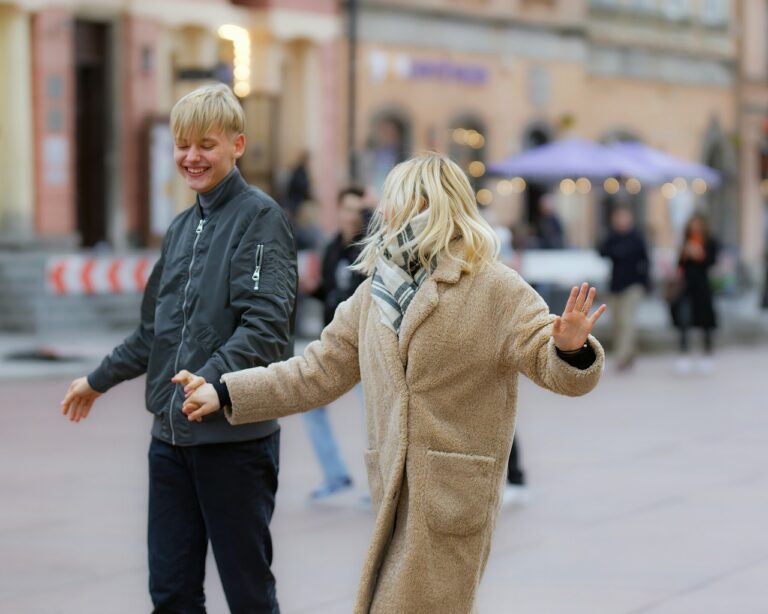The Language of Love: Unpacking the Meaning of Dating
What’s in a Word: Exploring the Different Terms for Romantic Relationships
Romantic relationships, those beautiful connections that make our hearts flutter and our emotions soar, have been a topic of fascination for centuries. And yet, the language we use to describe these relationships is constantly evolving. From the traditional terms like boyfriend and girlfriend to the modern variations like partner and significant other, the words we choose to define our romantic connections can reveal a lot about our values, beliefs, and even our societal norms.
Take, for example, the term “boyfriend” or “girlfriend.” These terms are commonly used to describe a romantic relationship between two people who have committed to each other. They are often associated with a sense of youthfulness and playfulness, evoking images of treasured moments in high school or college. However, as our society has become more inclusive and aware of gender identities, the term “partner” has gained popularity. This term is generally used to describe a relationship where two people are in a committed, long-term partnership, regardless of their genders. It carries a more mature and equal connotation, highlighting the importance of equality and shared responsibilities in a romantic relationship.
The First Encounter: Decoding the Signals and Body Language of Attraction
The first encounter with someone new can be both exhilarating and nerve-wracking. As we interact with someone for the first time, we often rely on nonverbal cues to gauge their interest and attraction. Body language plays a crucial role in these initial interactions, as it can reveal a great deal about a person’s feelings and intentions.
For example, eye contact is a powerful signal of attraction. When someone maintains steady eye contact and dilated pupils, it indicates that they are genuinely interested and engaged in the conversation. On the other hand, avoiding eye contact or constantly looking away may suggest disinterest or shyness. Similarly, a genuine smile that reaches the eyes can communicate warmth and openness, while a forced or closed-lip smile may imply insincerity.
Besides eye contact and smiles, there are several other body language cues to watch out for during a first encounter. Mirroring, where two people adopt similar gestures or postures, is a sign of connection and rapport. Leaning in closer, leaning towards the person, or touching their arm lightly while speaking can indicate interest and attraction. On the contrary, crossed arms, fidgeting, or distancing oneself physically may signal discomfort or disinterest.
Pay attention to these subtle cues during your first encounter, as they can reveal more about someone’s feelings and intentions than their words ever could. By decoding the signals and understanding body language, you can gain valuable insights into the attraction and connection between you and your potential partner. So next time you meet someone for the first time, don’t forget to observe the unspoken messages their body is sending, as it may hold the key to a deeper connection.
From Flirting to Dating: Understanding the Transition and its Significance
Flirting, a playful and teasing way of showing interest, is often the first step towards building a romantic connection. It involves subtle gestures, flirty banter, and the exchange of compliments. The transition from flirting to dating is a crucial turning point in any relationship. It signifies the mutual interest and attraction becoming more serious and intentional. It is where two individuals move from the realm of playful ambiguity to a more defined and exclusive partnership.
Understanding the significance of this transition is vital for navigating the dating landscape successfully. It marks the shift from casual interaction to a deeper emotional and romantic connection. In this phase, both parties start investing more time and effort into getting to know each other on a more personal level. The transition from flirting to dating sets the stage for a more exclusive and intimate relationship, where vulnerability and commitment are present. It’s a thrilling and exciting period where individuals start exploring the potential of a long-term partnership.
Navigating the Digital Age: How Technology Has Impacted Modern Dating
In today’s modern world, technology has undeniably become an integral part of our lives, infiltrating almost every aspect, including our love lives.

With just a few swipes or taps on our screens, we can now connect with potential partners across the globe. The digital age has opened up a vast pool of opportunities, making it easier for us to meet new people and explore romantic connections. However, this convenience comes with its own set of challenges. While technology has bridged distances, it has also created a sense of ambiguity and uncertainty. We find ourselves wondering if the person on the other end of the screen truly represents who they claim to be. The digital age has forced us to develop a new set of skills and instincts, as we navigate the online dating world and decipher genuine connections from mere virtual façades.
• The digital age has made it easier for us to meet new people and explore romantic connections.
• Technology has bridged distances, allowing us to connect with potential partners across the globe.
• However, this convenience comes with challenges such as ambiguity and uncertainty.
• We often question if the person we’re interacting with online is truly who they claim to be.
• Navigating the online dating world requires developing new skills and instincts.
Love Languages: Unveiling the Different Ways People Express Affection
In the realm of romantic relationships, it is often said that actions speak louder than words. This sentiment is especially true when it comes to understanding the love languages of individuals. Love languages refer to the different ways people express affection and feel loved by their partners. By uncovering and exploring these unique languages, couples can build stronger connections and improve their overall relationship satisfaction.
One commonly recognized love language is physical touch. For individuals who primarily speak this language, physical intimacy such as handholding, hugging, and kissing is vital in expressing their love and feeling connected to their partner. Simple gestures like a gentle touch on the arm or a back rub can go a long way in making them feel loved and valued. On the other hand, some people resonate more with verbal affirmations. Hearing words of love and appreciation, such as “I love you” or compliments about their character or appearance, can fill their love tanks and make them feel truly cherished.
The Unwritten Rules: Social Norms and Expectations in the Dating World
In the world of dating, there are unwritten rules that often dictate social norms and expectations. These rules are not explicitly stated but are understood and followed by individuals engaging in romantic relationships. From the first encounter to the development of a deeper connection, these unwritten rules guide the actions and behaviors of those involved.
One of the most common unwritten rules in the dating world is the expectation of clear communication. It is important to express one’s intentions and desires openly and honestly, as this sets the foundation for a healthy and respectful relationship. Additionally, there is an unspoken expectation for both parties to be respectful of each other’s boundaries and personal space. This includes not pushing for physical intimacy before both individuals are comfortable and ready.
Another unwritten rule often seen in the dating world is the expectation of reciprocity and mutual effort. It is generally understood that both parties should contribute equally to the relationship by investing time, energy, and emotions.


Unwritten rules in the dating world can vary depending on cultural, societal, and individual factors. While understanding and following these rules can contribute to a positive dating experience, it is equally important for individuals to be true to themselves and their own values. The dating world can sometimes be a maze of expectations, but by navigating it with mindfulness and respect, one can increase the chances of finding a fulfilling and genuine romantic connection.
Beyond Words: Exploring Nonverbal Communication in Romantic Relationships
Nonverbal communication plays an essential role in romantic relationships. It goes beyond the words spoken and encompasses gestures, facial expressions, and body language. These nonverbal cues offer crucial insights into our partner’s feelings, desires, and emotions, often revealing more than what words can articulate. Whether it’s a subtle glance, a gentle touch, or a warm embrace, these nonverbal signals create a deeper connection and understanding between partners.
One of the most powerful nonverbal forms of communication is eye contact. When our eyes meet with our partner’s, it can express sincerity, love, and trust. Eye contact can convey a multitude of emotions without uttering a single word. It can establish a strong sense of intimacy and strengthen the emotional bond between two individuals. In fact, research suggests that prolonged eye contact can release a hormone called oxytocin, often referred to as the “love hormone,” which promotes feelings of attachment and closeness. So, next time you lock eyes with your significant other, pay attention to the unspoken language that passes between you, as it holds the potential to deepen your connection even further.
Love in the Digital Era: The Rise of Online Dating and Its Effects
Online dating has seen a dramatic increase in popularity in recent years, thanks to the advances in technology and the widespread use of smartphones. With just a few swipes and taps, individuals are now able to connect with potential partners from all over the world. The rise of online dating has undoubtedly changed the way people approach relationships and has had a profound effect on the dating landscape.
One of the major effects of online dating is the sheer accessibility it offers. In the past, meeting someone new often required going out to social events, joining clubs, or relying on introductions from friends. With online dating, however, individuals can now connect with others right from the comfort of their own homes. This convenience has not only expanded the dating pool, but it has also allowed individuals to be more selective in their search for a compatible partner. No longer limited by geographic boundaries or social circles, online daters have the freedom to explore different people and find someone who truly matches their interests and values.
The Love Equation: Balancing Independence and Vulnerability in Relationships
In any romantic relationship, balancing independence and vulnerability is key to finding a healthy and fulfilling love equation. It’s about finding the sweet spot between retaining your individuality and opening yourself up to emotional intimacy.
Independence in a relationship means maintaining your own identity, hobbies, and personal goals. It’s about nurturing your own passions and pursuits while still being a part of a partnership. By having a sense of independence, you bring unique perspectives and interests to the relationship, enriching it with diversity and personal growth. It also ensures that you don’t lose yourself in the process of being with someone else. However, it’s essential not to let independence become a wall that isolates you from your partner. It’s important to communicate your needs and desires, finding the right balance between personal space and shared moments.
The Journey of Love: Embracing the Challenges and Celebrating the Joys of Dating
Dating can be a rollercoaster ride filled with ups and downs, but it’s all part of the journey of love. From the excitement of meeting someone new to the challenges of navigating through misunderstandings and conflicts, every stage has its own set of joys and hurdles. It’s crucial to embrace these challenges and not be discouraged, as they provide opportunities for personal growth and understanding. By approaching dating with an open mind and heart, we can learn to appreciate the beauty in both the highs and lows, ultimately leading to a stronger and more fulfilling relationship.
Celebrating the joys of dating is equally important. Whether it’s the butterflies in your stomach during a first date or the comfort of knowing you have someone special by your side, there are countless reasons to celebrate the love that enters our lives. These moments of joy remind us of the magic in human connections and the happiness that comes from sharing our lives with someone who truly understands and supports us. Taking the time to acknowledge and appreciate these joys not only strengthens our bond with our partner but also serves as a reminder of the importance of love and connection in our lives.
What are the different terms for romantic relationships?
There are various terms for romantic relationships, such as boyfriend/girlfriend, partner, significant other, or even just dating someone.
How can I decode signals and body language of attraction during the first encounter?
Pay attention to nonverbal cues like eye contact, smiling, leaning in, and mirroring gestures. These could be signs of attraction.
What is the significance of the transition from flirting to dating?
The transition from flirting to dating signifies that both parties are interested in exploring a potential romantic relationship and are willing to invest more time and effort into getting to know each other.
How has technology impacted modern dating?
Technology has revolutionized modern dating by providing platforms like dating apps and social media, making it easier to connect and meet new people. However, it has also introduced new challenges like miscommunication and ghosting.
What are love languages?
Love languages are different ways people express and experience love, including words of affirmation, quality time, receiving gifts, acts of service, and physical touch.
What are the social norms and expectations in the dating world?
Social norms and expectations in the dating world can vary, but some common ones include being respectful, communicating openly, and being honest about intentions.
How important is nonverbal communication in romantic relationships?
Nonverbal communication plays a significant role in romantic relationships as it can convey emotions, desires, and intimacy without the need for words.
How has online dating affected the way people find love?
Online dating has expanded the pool of potential partners and made it more convenient to meet people. However, it also comes with challenges such as the potential for dishonesty and superficial judgments based on profiles.
How can one balance independence and vulnerability in a relationship?
Balancing independence and vulnerability in a relationship is about maintaining one’s individuality while also being willing to open up, be vulnerable, and trust your partner.
How can I embrace the challenges and celebrate the joys of dating?
Embracing the challenges and celebrating the joys of dating involves maintaining a positive attitude, having realistic expectations, and being open to personal growth and new experiences.






